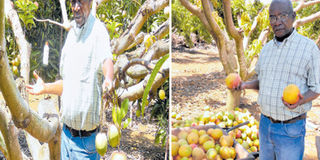I have picked my pension from mangoes for 14 years

Gerald Gicheru, 70, a former senior civil servant in the Treasury in his farm in Chuka where he has been growing fruits since his retirement. He practices mulching, which insulates the soil helping to provide a buffer from heat and cold temperatures and keeps weeds at bay. PHOTO | CAROLINE WAMBUI | NMG
What you need to know:
- Gicheru, who retired in 2004, says he ploughed Sh200,000 from his savings into the venture.
- Mango trees must be pruned to control the overall height.
- Improper pruning, according to Gicheru, makes mango fruits acquire different shades, some having black marks that make them unmarketable as the market prefers mangoes with a uniform colour.
- The fruit fly is the worst enemy of mangoes that affects sale of the produce in the local and global markets.
Huge chunks of land stretch yonder as we traverse Itugururu, some 17km from Chuka in Tharaka Nithi County.
The road is bumpy and dusty, making the vehicle leave a cloud of dust as we head to Green Fare Acres at Igamatundu sub-location, where Gerald Gicheru, 70, a former senior civil servant in Treasury is farming fruits.
The 25-acre farm hosts mangoes (seven acres), bananas (seven acres), macadamia (2½ acres), butternut (three acres) and arrowroots (one acre).
Gicheru, who retired in 2004, says he ploughed Sh200,000 from his savings into the venture.
He confesses that he had failed terribly as a subsistence farmer for several years and upon retirement, he consulted agricultural specialists at the Ministry of Agriculture on the best crops to grow.
“I was advised to use the hot sun as a blessing to produce the Sweet Apple variety of mangoes. I learnt that when the weather is worse between June and September, mango trees flower producing some of the sweetest fruits.”
But with growing mangoes came another challenge as a continuous canopy formed on the farm translating to reduced yields with time.
Another hindrance arose when the mangoes matured once a year at the same time in the region flooding the market, thus, leading to wastage and low prices.
To overcome the challenges, Gicheru further planted late-maturing Kent variety of mangoes that sees him be in the market when the supply is low and demand high.
The farmer has now mastered the art of mango farming, noting he grows the crop at 30 feet by 30 feet and it needs soil with a pH of 4.5-7.0.
“Mango trees must be pruned to control the overall height and this should start when the tree is at its infancy. Pruning should take place immediately after harvesting to open the plant to light and allow the tree to grow horizontally while improving flowering and fruiting.”
Improper pruning, according to Gicheru, makes mango fruits acquire different shades, some having black marks that make them unmarketable as the market prefers mangoes with a uniform colour.
Gicheru practices mulching, which insulates the soil helping to provide a buffer from heat and cold temperatures and keeps weeds at bay.
JOB AFTER RETIREMENT
In a good season, the farmer harvests 15-20 tonnes of mangoes. At the farm level, the price of a piece of mango averages between Sh15 and Sh20 and a kilo averages between Sh30 and Sh50.
At the banana section, Gicheru farms seven different varieties that include FHIA 17, FHIA 18, Grand Nain, Williams, Jian Cavendish, Uganda Green and Kampala with most of the varieties that he grows yielding fruits that weigh up to 123kg. The banana section is subdivided into small portions, each hosting its own variety.
To curb water shortage in the semi-arid region, Gicheru has dug shallow wells to ensure a continuous supply of water as he says that each banana plant requires at least 20 litres of water per week.
“Lack of water makes the banana steam weak leading to fall of the plant before maturity,” he explains.
His main challenge is with sweet bananas, which he says are attacked by diseases frequently yet they fetch a premium price in the market with a kilo going for Sh120. The average price of a bunch ranges from between Sh600-Sh1,200
“When a farm is well-mulched, crops thrive as the organic matter serves as mulch which holds the available moisture to feed the growing crops. Mulches moderate soil temperature and help in vigorous root growth,” David Mugambi, a lecturer in natural resources management at Chuka University says.
“During the cold season, a well mulched farm is much warmer, and while during the hot seasons, the farm is much cooler giving the crops a conducive environment for growth.”
Once the mango fruits mature, they should be handpicked.
“There should be no shaking of trees. Every piece has to be picked, selected for its quality and packed in specific cartons for sale if they are to fetch a premium price.
Gicheru says the farm has not only offered him a job after retirement, but also keeps him busy and he has income to comfortably run his home.
“Farmers should specialise by farming one-line crops that they will give maximum attention to without eating down their income. Such crops will ensure minimal usage of labour thus boost profits. For me I engage in horticulture, I don’t keep animals.”
****
The fruit fly is the worst enemy of mangoes that affects sale of the produce in the local and global markets.
Farmers should curb the pest using fruit fly traps. The trap is made of a plastic bottle, which has small holes on both sides.
Inside the bottle, a piece of cotton wool is soaked with female fruit fly hormone to lure the male fly, which is killed by pesticides one it enters the bottle.





